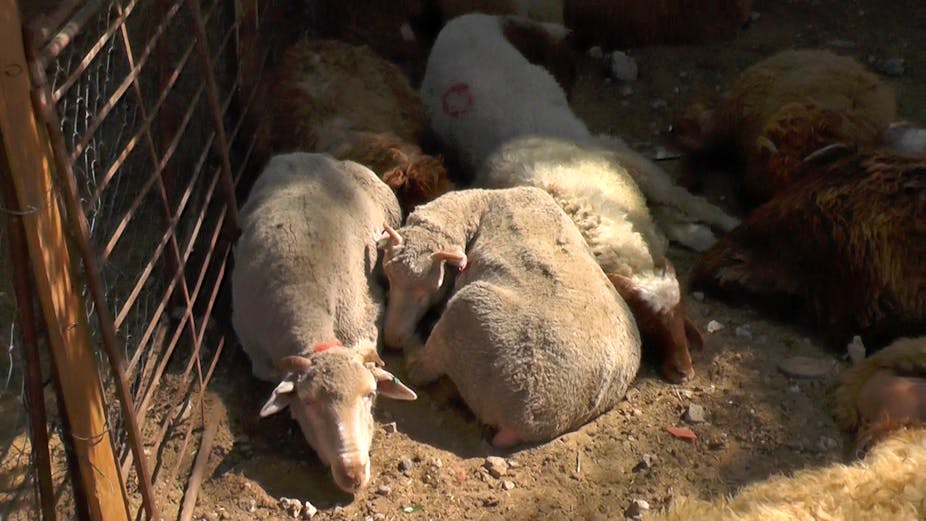Last week, video footage of animal cruelty kicked off yet another live export controversy. The footage appeared to show not just confronting and inappropriate animal treatment, but the likely movement of Australian-exported sheep outside designated buyers and slaughter plants.
The government has responded by expressing support for live export, coupled with a promise to investigate and deal with any breaches in the ESCAS - the export supply chain assurance scheme.
Confronted with repeated incidents over the past few years, the Australian public may well ask, “Why hasn’t this been fixed?” and “Can live export ever be made humane?”.
Live export presents a singularly difficult problem for ensuring animal welfare.
It is generally accepted that the longer and more complex the journey an animal makes, the greater the risk to its welfare. That’s not to say that the welfare of an animal for a longer journey necessarily has to be worse, but the risks tend to be greater and need more complex management.
The most critical reason why it is difficult to ensure animal welfare in live export is because exported animals are beyond Australia’s sovereign control. They are beyond our laws and our capacity for enforcement.
The Australian government has tried to address this hurdle by negotiating Memorandums of Understanding with importing countries. In addition, the export supply chain assurance scheme was developed to achieve animal welfare control. It provides regulatory oversight of the contractual arrangements that exist down the supply chain, and limits Australian-derived animals to certain buyers and slaughter places.
But live export is difficult to “fix” because the direction of animal welfare concern is completely separate to the direction the animals travel as they are bought and sold through the export process.
In other circumstances, many farm animal welfare issues are eventually fixed by market-based change. For example, consumers start demanding animal welfare attributes like sow-stall-free pork, and the market provides them. As a result, animal welfare improves.
Live export presents a unique problem, because the location of greatest animal welfare concern is the Australian public, and the Australian public has absolutely no market power in the equation. We’re not the ones buying the cows.
In making these points, it is fair to acknowledge that importing countries have animal health and welfare requirements. It is just that these requirements may be different to what the public in this country expects for Australian animals.
Animal welfare in live export has proved difficult to solve because of the complex risks involved, the inability to enforce Australian laws beyond our borders, and the need to improve animal welfare by “pushing” standards down the supply chain, rather than having them “pulled through” by buyer demand.
The key question remains - can live export ever be humane?
The industry has improved aspects over the past 20 years. There have been declines in published mortality rates on ships, and the industry has instituted training programs for animal handlers in importing countries.
But while live export continues, adverse animal welfare incidents will come to light. One simple reason for this is that no system or level of legal oversight can guarantee that nothing bad will happen. Even in Australia we can’t stamp out incidents of animal cruelty altogether.
It is also difficult to guarantee that no Australian animals will be bought or sold outside the designated supply chains. But if each instance is properly addressed and fixed, then hopefully the prevalence of leakage and the incidence of animal mistreatment should decline.
Will that be enough?
Essentially, it seems that live export will be humane enough for some people, not humane enough for others, and will never be humane in the assessment of animal welfare organisations. The relative proportions of Australians in these three categories will depend not just on the frequency and level of problems, but on the efforts of government and industry to improve animal welfare, and the transparency of their results.
When animal welfare incidents happen, live export industry advocates commonly highlight Australian industry’s efforts to improve animal welfare in destination countries. They point out that other countries’ exporting industries do not have similar programs.
These statements, while legitimate, are unlikely to convince the public to accept the industry in the face of occasional but ongoing incidents.
A more sustainable approach requires not just a stated commitment to improvement, but also transparency of both process and results for animal welfare performance. Both have to be seen to improve. Currently, the public is left with the impression of a repeating story of “We have it all fixed now”, followed by animal welfare activist footage indicating that all is definitely not fixed.
Government support for the live export industry seems firm. The key issues will be improving the welfare of animals and trying to limit the damage to the political capital of not just the live export industry, but also Australia’s livestock farming industries in general.
One day, events may arise that require significant public investment and support. It may be an emergency animal disease, environmental policies, or terms of trade that drastically damage the industry’s viability. It may not be a direct trade-off, but one day Australia’s farmers may need their political capital and the residual goodwill of the Australian public more than they need the live export industry.

